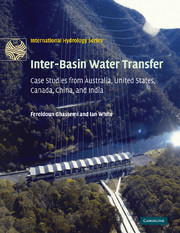Book contents
- Frontmatter
- Contents
- Foreword
- Overview and Scope
- Acknowledgements
- List of Abbreviations
- Part I The Challenges
- Part II Inter-basin Water Transfer in Australia
- Part III Inter-basin Water Transfer in Other Selected Countries
- Part IV Appendices
- Appendix A Some of the Australian pioneers of inter-basin water transfer
- Appendix B Construction timetable of the Snowy Mountains Hydro-electric Scheme
- Appendix C Details of diversion schemes from the Clarence River Basin
- Appendix D Chronological table of the most important events in the Goldfields Pipeline Scheme, Western Australia
- Appendix E Flooding of the Sahara depressions
- Appendix F The Ord River Irrigation Scheme
- Appendix G The West Kimberley Irrigation Scheme
- Appendix H Some other water transfer schemes in Australia
- Appendix I Selected technical features of the Central Valley Project in California
- Appendix J Selected technical features of the State Water Project in California
- Appendix K Selected characteristics of some of the completed or proposed inter-basin water transfer projects in Australia, United States, Canada, China and India, in chronological order
- Glossary
- Index
- References
Appendix G - The West Kimberley Irrigation Scheme
Published online by Cambridge University Press: 05 November 2009
- Frontmatter
- Contents
- Foreword
- Overview and Scope
- Acknowledgements
- List of Abbreviations
- Part I The Challenges
- Part II Inter-basin Water Transfer in Australia
- Part III Inter-basin Water Transfer in Other Selected Countries
- Part IV Appendices
- Appendix A Some of the Australian pioneers of inter-basin water transfer
- Appendix B Construction timetable of the Snowy Mountains Hydro-electric Scheme
- Appendix C Details of diversion schemes from the Clarence River Basin
- Appendix D Chronological table of the most important events in the Goldfields Pipeline Scheme, Western Australia
- Appendix E Flooding of the Sahara depressions
- Appendix F The Ord River Irrigation Scheme
- Appendix G The West Kimberley Irrigation Scheme
- Appendix H Some other water transfer schemes in Australia
- Appendix I Selected technical features of the Central Valley Project in California
- Appendix J Selected technical features of the State Water Project in California
- Appendix K Selected characteristics of some of the completed or proposed inter-basin water transfer projects in Australia, United States, Canada, China and India, in chronological order
- Glossary
- Index
- References
Summary
INTRODUCTION
In May 1991, John Logan, a cotton grower from Narrabri arrived in Broome to study prospects of developing land and water resources of the Fitzroy River region for large-scale irrigation production. Previously, he completed a topographic desktop evaluation of the area, and travelled to Indonesia in April 1991 to assess the likely future marketing opportunities for large-volume supply of cotton for export from the port of Broome (John Logan, personal communication, August 2003).
In 1992, the Hon Ernie Bridge, Minister for Water Resources of Western Australia, initiated a series of studies to investigate ways to take advantage of the Kimberley water resources. In 1993, the Kimberley Water Resources Development Office initiated studies to investigate development opportunities for the Fitzroy valley (Water and the West Kimberley: A Community Newsletter, June 1996).
Following is a brief description of the West Kimberley Irrigation Scheme mainly from the website of the Department of Industry and Resources.
In February 1996, the Western Australian Government recognised the capacity for large-scale integrated agricultural development in the West Kimberley. Following calls for Expression of Interest, in mid-1997 the Government announced Western Agricultural Industries Pty Limited (WAI) as the preferred proponent to develop the project. WAI was appointed by the WA Government to carry out feasibility studies into establishing an irrigated agricultural industry based on the groundwater resources of the Cretaceous Broome Sandstone in the Canning Basin and surface water resources of the Fitzroy River.
- Type
- Chapter
- Information
- Inter-Basin Water TransferCase Studies from Australia, United States, Canada, China and India, pp. 393 - 396Publisher: Cambridge University PressPrint publication year: 2007



